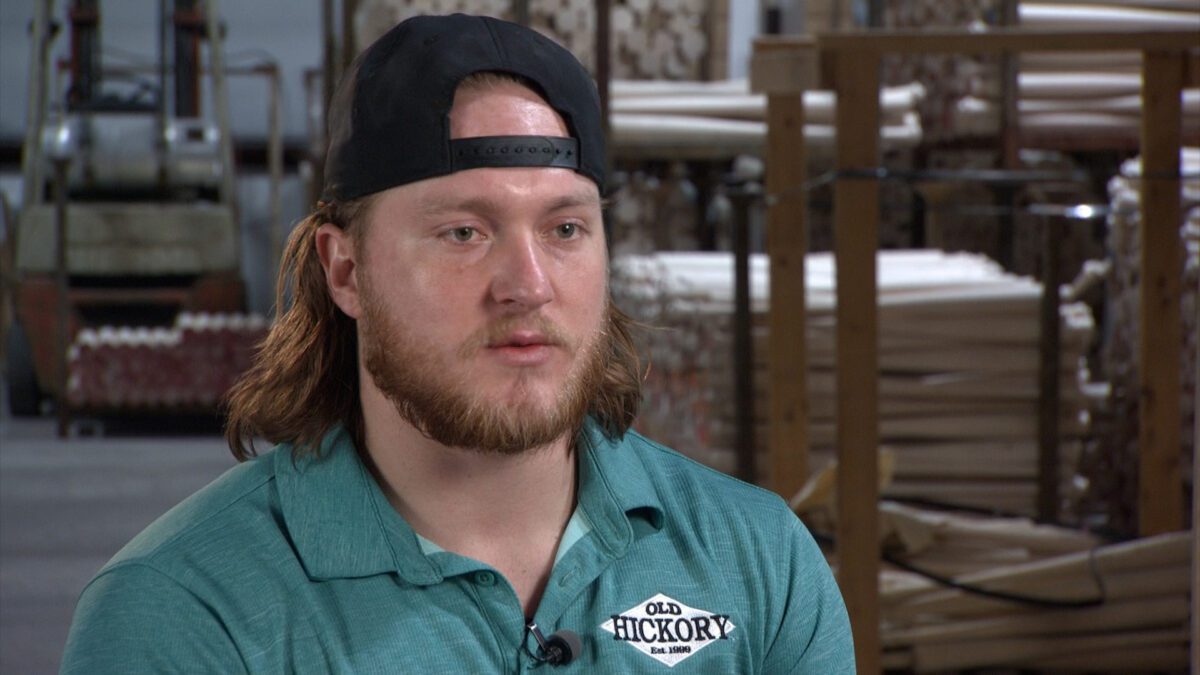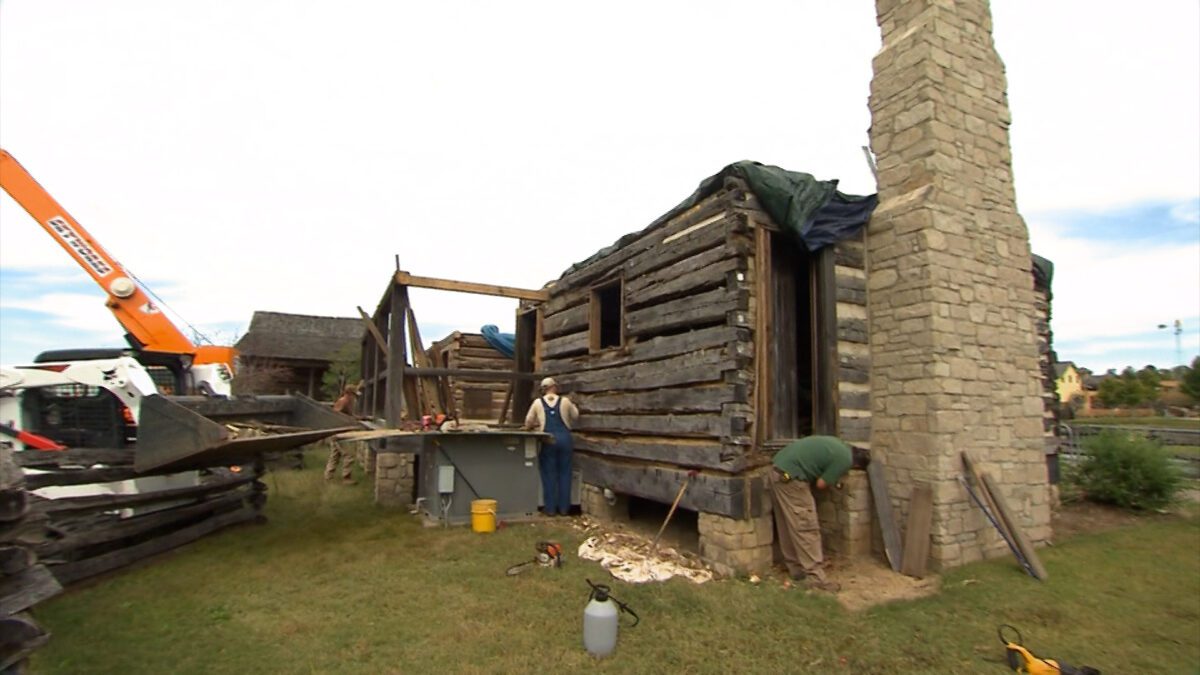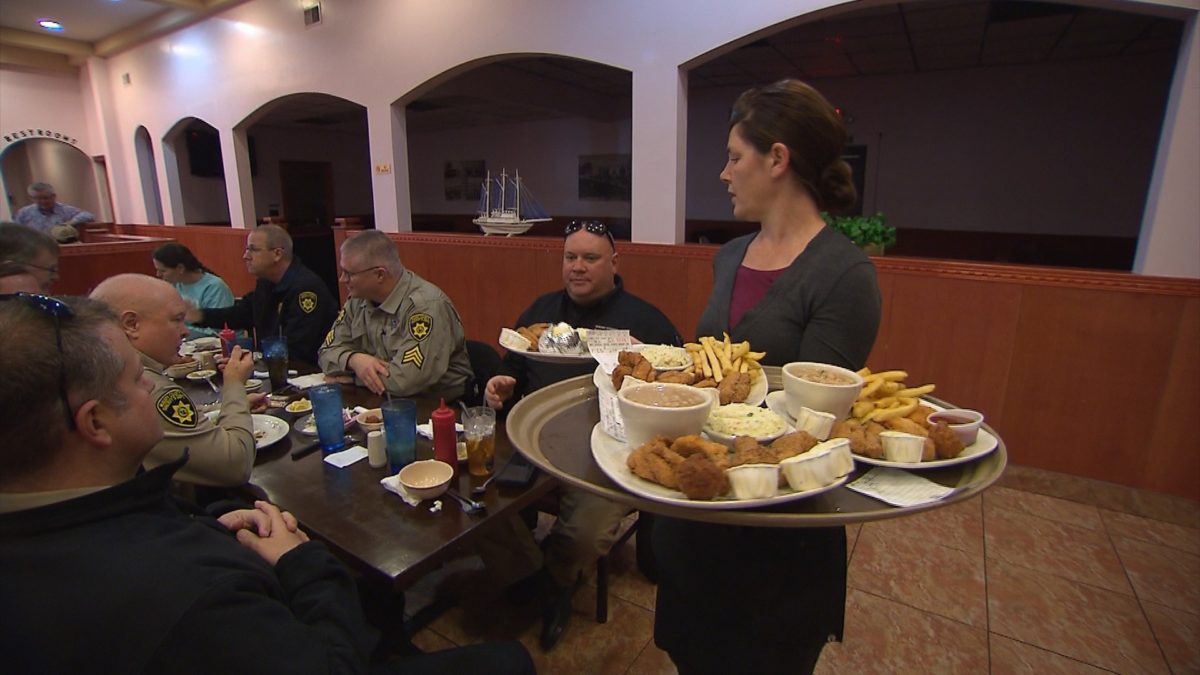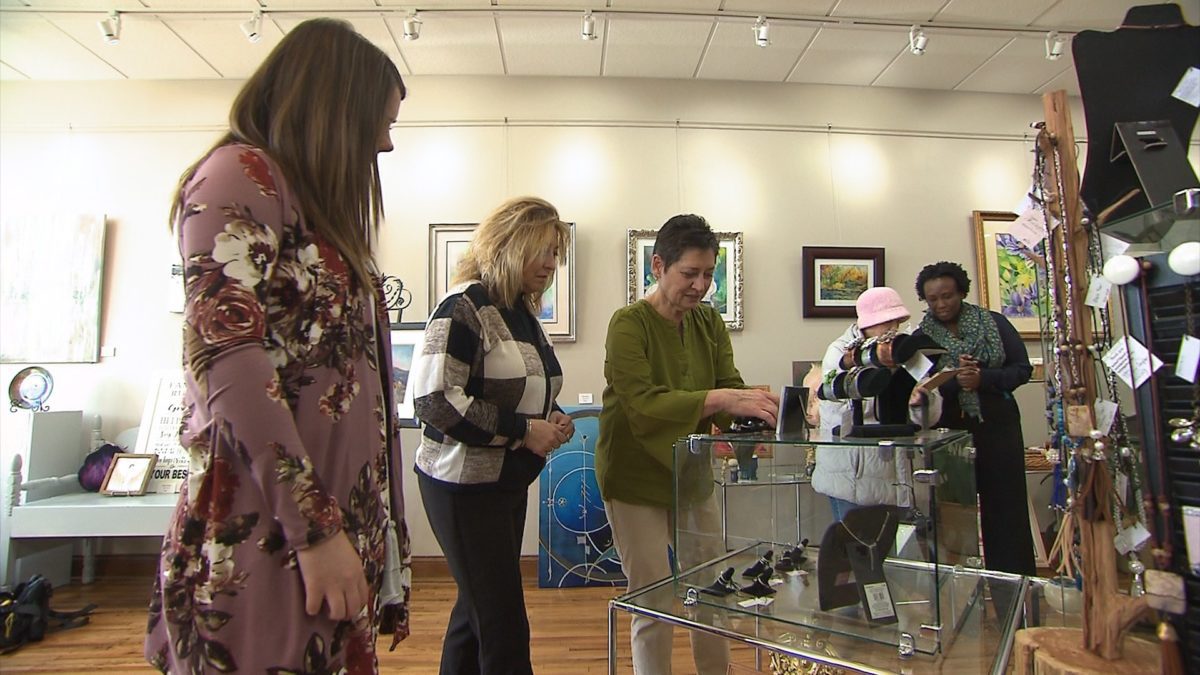Episode 3640
Don't have the PBS App? Click Here
Episode Transcript
- [Announcer] "Tennessee Crossroads" is made possible in part by. - [Phil] I'm Tennessee Tech President Phil Oldham. Here in Cookeville, Tennessee's college town, we are bold, fearless, confident, and kind. Tech prepares students for careers by making everyone's experience personal. We call that living wings up. Learn more at tntech.edu. - [Announcer] Averitt's Tennessee roots run deep. They've been delivering logistics solutions here for over 50 years, and though Averitt's reach now circles the globe, the Volunteer State will always be home. More at averitt.com. - This time on "Tennessee Crossroads", we discover why a company in White House is a hit in the world of baseball. Then we'll witness the preservation of a pioneer village near Union City. We'll visit a place in Lafayette where local artists are thriving, and wind up in Columbia at a campus for catfish. Hi everybody. That's the lineup for this edition of "Tennessee Crossroads". We're sure glad to have you. The next time you're at a ballpark enjoying the great American pastime, pay a little extra attention to the bat. Whether you're at a minor league game or watching the stars of the majors, there might be a Tennessee connection. In our first story, Miranda Cohen swings for the bleachers over in the town of White House. - [Miranda] The sound is unmistakable. It is the sound of America's favorite pastime, baseball. The game caught on in the late 1800s and has been a national craze ever since. - So baseball and life go hand in hand, the lessons that you learn and everything. So it's a great family sport and it's something that will be around forever. - [Miranda] Ryan Mortenson, or as his friends call him, Morty, has what some would consider a field of dreams job working here at the Old Hickory Bat Company. - You obviously don't have to play baseball to be able to work here but it's that baseball fit and that baseball kind of personality and environment that kind of really encapsulates kind of what we do here at Old Hickory. We are a team. It's more of a family. Obviously we're sitting on family land that the company was started on. So Chad's more of like a father figure than a boss. - [Announcer] Chad is owner and founder, Chad Lamberth. He and his partners started the old Hickory Bat Company back in 1999 in a garage with a loan from his mother and a love for the game. Today he and about 15 employees working in this 6,000 square foot center will turn out about 250 bats a day. - So we just supply to anyone and everyone that needs a baseball bat. So we supply drop five weighted ounce bats. So that's for younger amateur players, for younger kids, all the way up to all 36 MLB teams. - [Miranda] Only wooden bats are used in the major leagues, and because of that, more and more coaches are starting to put wooden bats in the hands of their younger players, and that is just fine with these guys. - True wood bat with good grains and everything is gonna give you as much pop, if not more. And it just gives you a better feel for the ball. You understand where you're hitting the ball on the barrel and everything. It takes away that room for error and just kind of makes you a better hitter. - About 95% of the bats will be made from sturdy maple wood, but they will also use birch or ash depending on the hitter's personal preference. With custom made choices of grip, color, size, and weight, the Old Hickory Bat Company can create more than 10,000 variations of a bat. And once all of the decisions have been made, this all-star team will go to work. Okay, Ryan, just walk us through this process. This is the way the wood looks when it comes into Old Hickory Bat Company. - Yes ma'am. So the trees will be chopped down up in Pennsylvania and New York. They'll cut 'em into pieces like this. This is what I call a rick. It'll look like this. They'll put it in a lathe, has really sharp and fine knives, spin it in a circle, knock those corners off, make it a little bit more of a rough cylinder like that. And then from there, they'll put it in an even finer lathe that has sharpened and finer knives, cut it into that perfect cylinder. From there, they'll weigh it out, put it in a kiln. Let's it get all the moisture out of it, and that's what gives it that pretty white color right there. From there, it'll come to us and it'll become a bat. - [Miranda] Before they are swinging for the bleachers, these bats will be meticulously hand sanded over and over. They will then be weighted, painted, and lacquered. Finally, finished with an Old Hickory Bat Company logo. - So that's kinda one of the great things about Old Hickory is everything's done by hand. So each process, someone's looking at it. So from the time that the Billy gets picked up by the cutter, coming off the machine to each sander, to the paint guys to our final engraver, that's four to five different new sets of eyes that are gonna be looking at the bat. So nothing leaves the facility that's not up to our quality and our standard. - [Miranda] And if you think these bats look familiar, you're right. They may start out in the hands of little leaguers, but they may also end up in prime time, in the hands of major league stars like Byron Buxton, Matt Olson, Ke'Bryan Hayes, and Mike Trout. - At the age of 17, Mike picked up an Old Hickory bat at a tournament and never looked back. He's used us ever since then and he loves us and he'll always use us. Yeah, every night you turn the TV on, you can see someone using an Old Hickory bat and know that it came out of this facility. Touched all the guys that you know. - [Miranda] They are the team behind the teams, inspiring players of every age or skillset with every swing or crack of the Old Hickory bat. - Thanks, Miranda. Our next stop is Union City and the Discovery Park of America. Now it's a fun place to visit any time of the year, but we were there a while back exploring a mission to save a pioneer village. Now it's a project that required the unique talents of a team of Tennessee preservationists. Since Discovery Park of America opened in 2013, it's attracted millions of children and adults. And for good reason. With dazzling exhibits and interactive hands-on experiences, it's a first class destination for entertainment and education. A place to be inspired by science, technology, and of course history. An important historical component is here by the park's north lake. It's called The Settlement, a collection of 13 hand hewed log buildings from the 19th century, all donated by families from the area. Scott Williams, the park's president and CEO, showed me around. - Of course, the centerpiece is a statue of David Crockett. David Crockett settled here in 1822. He was one of the first settlers here and one of the first hunters in nearby, around nearby Real Foot Lake. And so we tell a little bit of the David Crockett story here as well. It's set up like a community, similar to what one would've found, probably the houses would've been spread out a little more apart as people farmed. We also have agriculture here so we have a heritage garden where people can see how fruits and vegetables and food was grown back then. So that's another way people can see what was going on in the past. - [Joe] But after nearly a decade of life at the park, the logs are definitely showing their age, mostly due to water damage. Damage that threatens both structural integrity and safety. - We sought out a lot of different people to talk to about what we should do, and we settled with Leatherwood because they seemed to get what we were all about. Of course they were Tennesseeans, which is a great thing for us. - [Joe] By the way, Leatherwood has provided historic building restorations across the country. The man in charge is company president Vic Hood. - No two projects are alike and we really are faced with doing something new all the time. And that's a part of the enjoyment of what we do. We're taking out the dobbing and chinking in the building, and we're trying to find areas that are decayed, what's decayed, what's not. And we're discovering quite a bit more decay than we anticipated. Most everything we've run into is related to water, and so that's been our main culprit in this case. - This is a painstaking months long project that'll cost the park about a half million dollars. A lot of expense, a lot of very hard work just to save a bunch of old logs. But when you're preserving a valuable piece of Tennessee history, it's all worthwhile. - Absolutely. We cannot forget our history. History is crucial to our future. And so as much as we and everybody else in Tennessee can help contribute to taking care of history, that's a great thing. - [Joe] The Leatherwood team started with the two smallest structures, a hog barn and smokehouse, then moved on to larger buildings. - [Vic] This is a dog trot log house. They call it the Davy Crockett house. And we had to disassemble the second story because it had shifted to one side and it was causing water to cascade down the side of the building. And as that water cascaded down, it was causing decay. - [Joe] A lot of those replacement logs came from this neglected 1800s house in Franklin. Each one carefully removed before transporting it to the Union City side. Along the way, Vic's discovered a number of problems due to a structure's original construction. No one said all settlers were expert craftsman. - They've cobbled that together and they did it on top of a log that they put in upside down. This is a half dovetail notch, but it's supposed to drain water, not catch it. See water hits there and it goes into the log that way. And if it flipped over, it wouldn't do that. - [Joe] Most of the cabins have survived about two centuries of weather and wear. Now thanks to some new and old technology, visitors can safely and realistically experience 19th century life in the country. - Our objective here with this project is that the settlement will be around 10, 20, 30 years in the future so that children and adults who visit here will be able to see how things were done in the past, how people lived, how they built their cabins, how their food was preserved. We tell all those stories here at Discovery Park. - It's impossible to overestimate how much the arts enrich our lives. Music, sculpture, paintings, they all can transport us to another world or give us a new appreciation for the one we're in. Ciona Rouse discovered a place in Lafayette that helps local artists share their special gifts. - [Marla] To have something here that shows everybody's artwork and the tremendous talent that we have in the area is just phenomenal. - Phenomenal aptly describes a new addition to the square in Lafayette. Gallery 102 started as the brainchild of Russell Brown, a local attorney who recognized the need to support the artists of Macon County. So Russell, Lafayette is about 5,000 people, so it's a small town, but you have quite an art scene. - We do, we do, for a very small town. We have probably, I think per capita, more artists in Macon County than any other county in Tennessee. You can't prove that or disprove it, but that's my story. - [Ciona] His story was music to the ears of Evelyn White, the president of the Macon County Arts Council who remembers Russell's generous offer. - Russell came to the art council about three years ago now and offered the front portion of this building for an art gallery if we were interested. And so we were very interested and so we started talking. It took us about a year and just completed and got in just right before Christmas - [Ciona] And Gallery 102 became the Christmas gift that keeps on giving to artists as well as the community. - [Evelyn] We have several events during the year for the community. Arts in Bloom is a spring event that we have. And then we have Art in the Park, and that's usually the second week in June. And we have approximately 200 students that come. It's free to all the students, it's a two day event. But the art council furnishes all the supplies and their time and volunteers. - [Ciona] The gallery not only offers artwork and special events, it also encourages community members to create works of their own by offering classes. - We have just got started with the classes and hoping there'll be a lot more, but we're just asking each artist that is interested in doing the classes that they do offer their expertise in that area, and people are signing up. People are very interested in getting involved in learning something new and maybe starting a new hobby and doing that type thing. - The color you add will simply push the other ones underneath right out of the way. - One of our best classes so far, Miss Nancy Dawes, she's taught the alcohol inks and that has grown very fast. Everybody seems to be interested in that. And of course Miss Nancy is a wonderful artist and everybody wants to learn her techniques. We've got a felting class that we've started, a metalsmithing class for doing earrings. I hope to have a whole lot more but that's just kind of where we've started at. What we initially set out to do was get different mediums. We have, I think, captured a lot of the mediums to try to have a mix of all the different mediums to represent all of the art forms. - [Ciona] Gallery 102 artist, Marla Davis's preferred media are oil and acrylic, using a technique called Impasto. - You use acrylic paints and you mix it with a gel medium, and it gives it texture so that it makes it a little thicker, like an oil paint. And then I use a palette knife to apply it. So it's less of a precise method and it's really about layering and texture. So when you're done, you get that kind of stucco look, a texture to it. And then the vibrant colors from the acrylics. I'm less of a precise artist so there's something like this works for me. - [Evelyn] Lafayette is a small rural area, but we are richly blessed in talented artists and they share so beautifully with everyone. It's just a richness that helps to fulfill one's life. The beauty that is created. As you walk around the square, one of the things that the art council has done to enrich the county square is murals. We have murals that are up around the square. - [Ciona] Community support for the gallery has been overwhelming. - We have had so many to visit and stop by and ask how they can be a part of and want to be a part of it. And just very complimentary. They can't believe that little old Lafayette has an art gallery. They're just kind of blown away with what's happening. It's been great and the community has been so supportive and involved. It's been great. - Fried catfish. It's a southern comfort food that's kind of hard to beat. Some folks are obsessed with finding that perfect filet. Well, Tammi Arender found an of the way spot in Columbia called the Catfish Campus, where the fish is tasty and the folks are friendly. - Hey. - Hello. - [Hostess] How are y'all doing? - Good, and you? - Good. - Gotta have some hush puppies here. - Hey, brother. - How you doing? - I'm doing all right. How are y'all? - We're hanging right in there. - Hanging in there. - [Tammi] You may think with a name like Gary Bass, there would automatically be a fondness for fish. And yes, there is, but Gary and his wife Rhonda specialize in catfish, not bass. - The main draw is our catfish. We make our own batter for the catfish and we just lightly batter it. You get a lot more meat than you do batter. - [Tammi] Gary and Rhonda are the principals at Catfish Campus in Columbia, a mainstay in Mule Town since 1991. - Their venues and all was a school with all the fish in the desk, like a school of fish. They go in schools. And so that's how they got the name. - [Tammi] The Basses started in the restaurant business in a small town in northeast Arkansas. - We have another location in Arkansas, a little town called Caldwell, Arkansas that's right off of Interstate 40. A little town of 311 people, I believe. And a famous country singer was from there, a guy named Charlie Rich. They called him the Silver Fox and he was born right there close to where the restaurant's at. And we'll feed somewhere around 1500, 2000 people a week in a little town of 311 people. - [Tammi] Rhonda doesn't have a culinary degree but her upbringing taught her everything she needed to know about good Southern home cooking. - [Rhonda] I grew up in a family of 10 kids and I'm one of the older ones. So we helped do everything and learned to cook early and whatever, and I've always enjoyed it - [Tammi] And she's still enjoys it. You can often find her in the kitchen, even though the employees know the recipes by heart. Some of these employees have been a part of this establishment since they were kids - [Rhonda] All the years. I mean, we've seen them grow up. And babies that was here work for me now. And one of my managers, my main manager, he started for me when he was 15 year old. And now he has, when he started, of course, he was a busboy, a dishwasher, and he's worked his way up as manager. And then he has two sons that works for us. - So the quintessential Southern lunch. Got the turnip greens, the coleslaw, and that crispy fried catfish. I cannot wait to dig in. Although catfish is the calling card at this cafe, you can get just about anything your taste buds desire, steaks, seafood, chicken, and pork chops, and dessert. Don't dare forget the desserts. And some people just come for the sides. - [Rhonda] It is southern cooking and like our hush puppies, our slaw, everything we do from scratch, make our own. And so you're not getting prepackaged frozen stuff. It's all fresh. - A lot of people thought we'd just shut down. They didn't realize we'd moved back off the road. - It took a little while. - But see, we as a. - Good food and good service will bring you, I don't care where you go. - Yeah, right. - [Tammi] You'll seldom find Gary in the kitchen. He's all about public relations, literally. - How are you Mr. Bass? - I'm doing fine. - Good to see you, sir. - [Gary] I'm a PR guy, I guess you could say. I love the customers and I love to talk to 'em, find out where they're from. And of course, we've made a lot of friends over the years and we've got people that come in almost every day to eat. And we have people every week, if some of 'em don't show up on Friday night we're, oh no. What's wrong with this guy or this lady? We know 'em by name, not just by faces. We're just friends with a lot of people in the community. - [Tammi] Giving back to the community is also important. The Basses get to know their customers so well, they know when something is wrong or when someone is sick. - They're just almost like family. Yeah. When some of 'em are sick, I'll take 'em a meal or feed their whole family. Just take 'em what we call a family pack of chicken or fish or we'll mix it and make a combo out of it. And we've had a lot of people over the years that were close friends or good customers and when they'd get sick, couldn't go anywhere, I'd take 'em a meal every day. - [Tammi] That's really putting a restaurant to the test. And if you're a student of Southern cooking, then a trip to Catfish Campus will get you an A plus every time. - Well, I'm afraid that's all for this time. But in the meantime, don't forget about that PBS Video app where you can watch all your favorite shows anytime, anywhere. And of course, we want you to visit our website, tennesseecrossroads.org. Follow us on Facebook and join us next week. We'll see you then. - [Announcer] "Tennessee Crossroads" is made possible in part by. - [Phil] I'm Tennessee Tech President Phil Oldham. Here in Cookeville, Tennessee's college town, we are bold, fearless, confident, and kind. Tech prepares students for careers by making everyone's experience personal. We call that living wings up. Learn more at tntech.edu. - [Announcer] Averitt's Tennessee roots run deep. They've been delivering logistics solutions here for over 50 years. And though Averitt's reach now circles the globe, the Volunteer State will always be home. More at averitt.com.
Tennessee Crossroads
June 29, 2023
Season 36 | Episode 40
Miranda Cohen discovers why a company in White House is a hit in the world of baseball. Joe Elmore witnesses the preservation of a pioneer village near Union City. We’ll visit a place in Lafayette where local artists are thriving. And Tammi Arender winds up in Columbia at a campus for catfish.




